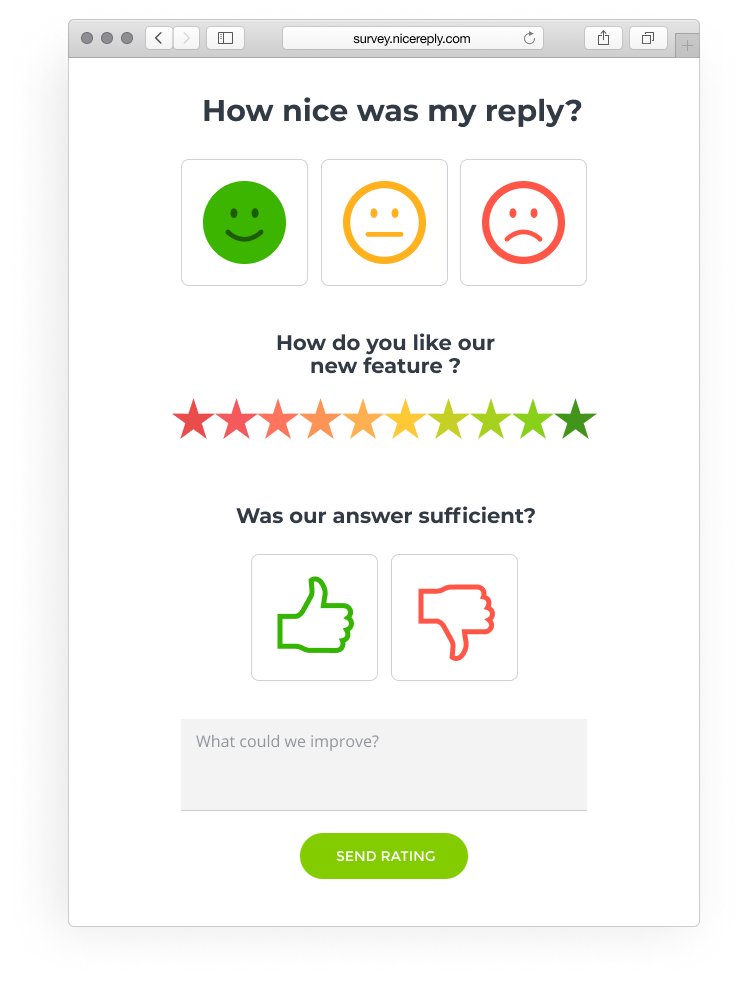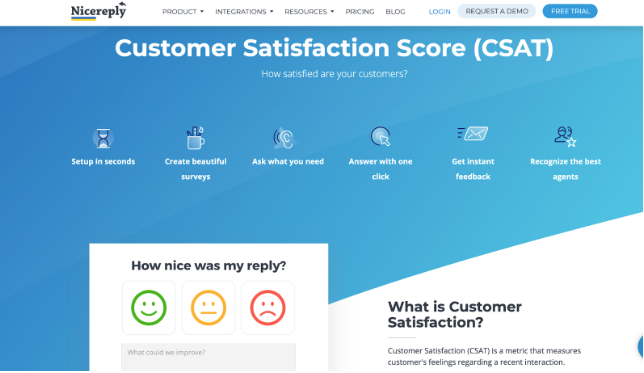Are you a B2B Business? Get the most out of your surveys and improve customer satisfaction.
Your business relies on customer satisfaction for a lot of things. If your customers are unhappy, they leave. But if they’re satisfied, they become loyal, purchase repeatedly, and consequently increase your revenue.
In the words of Chip Bell, “Loyal customers, they don’t just come back, they don’t simply recommend you, they insist their friends do business with you.
And isn’t that something you want for your business?
If you answered yes, then we urge you to keep on reading. Below, you’ll find seven actionable steps you can take to start increasing your customer satisfaction almost immediately.
Start your day
with great
quality
content
How to Improve Customer Satisfaction
1. Get a Better Understanding of Your Customers
As is often the case, the devil is in the details. If you want to substantially improve your customer satisfaction, generic survey questions won’t be enough. Instead, you need to dig deep and understand why people buy your products and services, how they do it, and the roadblocks that might hinder them.
But to do this, you’ll have to walk a mile in their shoes and find out when and where it starts to hurt. Start by investigating your customer journey from beginning to end, and then try to improve each step using actionable insights from Customer Satisfaction Surveys.
For example, you might find that people struggle with navigating your website and finishing purchases, so you can create a redesign and make that process as simple as possible. Or you may get a lot of questions about using your products and services. In that case, you can offer to walk customers through your product through an online call.
That personalized touch and extra care go a long way in making people feel valued.
2. Improve Customer Service
After signing up, customer service is the first human interaction many customers experience with your brand. You only get one chance at this first impression, and it’s in your best interest to get it right, as it influences every subsequent interaction and the customer’s view of your company as a whole.
If it’s a good impression, they become loyal fans. If it’s terrible, they leave. According to statistics, up to 65% of customers switch to a different brand when they have a poor experience, so you have to be mindful of improving your customer service.
One way to do this is to reduce the wait time. Onboarding an Interactive voice response (IVR) can help with this, especially if you’re a lean startup and your customer support team is overwhelmed. IVR is an automated system that allows your users to access self-help options or choose the correct routing via voice or keyboard.
Alternatively, you can improve the customer experience by building a robust FAQ page/knowledge base. 70% of customers prefer to answer their questions without help, so your knowledge base should contain answers to at least the most frequently asked questions. As a bonus, this also directs more traffic to your website.
Slack is a good example of this. The company has a solid knowledge base containing everything customers need. Check it out if you need ideas on building your knowledge base.
3. Provide Omni-Channel Support
Different customers have different ways they like to interact with brands. For example, someone enjoys calling up customer support to solve their issues, while a more introverted person may prefer reaching out via social media platform such as WhatsApp or live chat.
To keep your customers happy, you should cultivate a good selection of communication channels to cater to their preferences. That’s where omnichannel support comes in handy.
Omni-channel support doesn’t end at providing multiple touchpoints, however. It also synchronizes customer conversations and data across multiple channels and tools, which allows you to personalize your interactions with the previously acquired information.
Here are 6 simple tips on how to provide omnichannel support.
- Setup your own Virtual call centers
- Respond to customers via live chat messaging or use chatbots
- Onboard a CRM and answer your social media chats from one place
- Optimize your customer service experience for mobile
- Set up SMS texting
- Use live engagement tools like video calling
4. Deploy Automation
With the help of the best sales force automation software, you can close more sales, improve customer service and make your team more efficient. For example, your sales team can automate follow-up emails to increase top-of-mind awareness during the discovery or product demo stage. This prevents clients from dropping off due to burnout since the B2B sales cycle can last for weeks and sometimes even months.
Similarly, the customer service team can use workflow automation tools like the HubSpot integration for call centers to make their work easier and serve customers better. For example, combining HubSpot with call center software like Cloudtalk helps synchronize customer data across both platforms.
Automation starts from things as simple as chatbots to more complex integrations using Zapier. The ultimate goal is to give your customer a smooth experience on your platform and improve their satisfaction.
5. Collect Valuable Customer Feedback
With the integration, you can access accurate customer information from Hubspot when they call in, initiate calls from Hubspot and even transcribe calls.
Customers are at the center of your product, and you built your product to solve their pain points. So it’ll benefit you to get their thoughts on what to improve and implement it to keep them happy.
It’s important not to see feedback as an attack on your product, no matter how harsh it sounds. If customers give feedback, they want your product to be better. They won’t keep paying for something that doesn’t bring value
For example, let’s say that a large percentage of your customers are asking for a particular feature. When you build it and share it with them, they value the product more, leading to more satisfaction.
There are lots of ways to collect feedback. It all depends on your customer’s preferences, but here are the 5 most used approaches:
- Email: a simple email with a survey form will do the trick. You should get a lot of responses from your customers because they’re familiar with your email address. One trick is to use the CEO’s name in the subject line, as that’ll show that the email is important and boost your open rates and responses.
- SMS: this allows you to reach customers more cost-effectively. It’s also an easier way to reach a part of your customer base that is not so digital savvy.
- Social media: in addition to using it for marketing, social media is also a great way to get feedback. The upside of social media is that you don’t even need to prompt your customers before they share what they think about your product. A simple social listening analysis will tell you all you need to know.
- In-product: you can integrate a feedback form right into your product dashboard to get feedback. It makes it easy for your users as they don’t have to leave your product while providing feedback.
- Interviews: While this can be time-consuming, it’s also equally rewarding. That’s because you can see and hear your customers’ real thoughts about your product. This could be a simple video call or even an in-person interview if you have the resources to pull it off.
6. Reward Loyal Customers
When customers love your brand, they stick with you. They’re the first to pay for a new feature and tweet about how much they love it. Research suggests that loyal customers are 50% more willing to try a new product when you release one.
So imagine how they’ll feel when you start giving them extra benefits. By making loyal customers feel seen, heard, and appreciated, you show them that their faith is not misplaced, boosting satisfaction in the process.
Loyalty programs also boost customer retention, strengthen customer relationships, and ultimately boost revenue. For example, consider personalized discounts, gifts, additional services, premium features, or tools tailored for individual customers and their businesses.
7. Measure Customer Satisfaction Regularly
Measuring customer satisfaction score (CSAT score) is a direct way to know if your product or business is meeting your customers’ expectations.
Did you know that only 1 in 26 customers complain about a product? The remaining 25 go to your competitors. Measuring your CSAT scores is a great way to prevent this from happening. By being proactive, you can catch on to brewing dissatisfaction and nip a potential customer exodus in the bud.
For example, say you’re trying to measure the user experience of your product. From what you find, you can figure out which buttons to change or if you need to edit your mini copy for a better user experience.
There are different ways to measure customer satisfaction scores. Tools like Nicereply automate the entire process from start to finish.
Conclusion
Prioritizing customer satisfaction can give you an advantage over your rivals. It’s not hard to do, and it begins with little things like inquiring “What can we do today to make you more content?” If you don’t make customer satisfaction a priority, the result will be diminishing revenues as customers leave and your business closes.



















